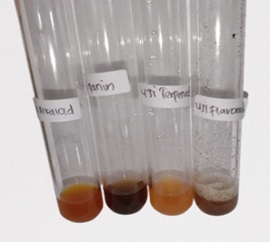The Implementation of FT-IR Method for Compound Detection in Eco-Enzyme Applied as Hydrogel Patch
Abstract
Potential organic waste includes fruit and vegetable peels which are used as eco-enzyme which are rich in benefits in several fields, one of which is in the health sector, namely hydrogel patch. The aim of this research is to identify the compound content in eco-enzyme and understand the impact of hydrogel patch on the process. healing open wounds. The research method used is the FT-IR method to detect the compound content of eco-enzyme which are applied as hydrogel patchs to heal open wounds in mice. The conclusion in this research is that the presence of flavonoid, alkaloid and tannin compounds in eco-enzyme has been identified and shows that the 5 treatments on eco-enzyme hydrogel patch have concentrations of 25%, 35% and 45% which are stable or 100% recovery, because the results One-Way ANOVA analysis in pre-clinical hydrogel patchs on mice in open wound healing showed a sig value of p = 0.283 > α (0.05). The analysis results show that the functional group (OH) appears at an absorption of 3293.56 cm-1, at an absorption of 2174.49 cm-1 it shows the presence of an Alkyl Nitrile functional group, the Amide functional group (CN) is found at an absorption of 1636.34 cm-1.
Downloads

Copyright (c) 2024 Diah Ayu SetiyaNingrum, Elvi Diah Nutfindiani, Zahra Margaretha, Meilisa Rusdiana Surya Efendi

This work is licensed under a Creative Commons Attribution-NonCommercial-NoDerivatives 4.0 International License.
Authors who publish with this journal agree to the following terms:
- Copyright on any article is retained by the author(s).
- The author grants the journal, the right of first publication with the work simultaneously licensed under a Creative Commons Attribution License that allows others to share the work with an acknowledgment of the work’s authorship and initial publication in this journal.
- Authors are able to enter into separate, additional contractual arrangements for the non-exclusive distribution of the journal’s published version of the work (e.g., post it to an institutional repository or publish it in a book), with an acknowledgment of its initial publication in this journal.
- Authors are permitted and encouraged to post their work online (e.g., in institutional repositories or on their website) prior to and during the submission process, as it can lead to productive exchanges, as well as earlier and greater citation of published work.
- The article and any associated published material is distributed under the Creative Commons Attribution-NonCommercial-NoDerivatives 4.0 International License.





_copy1.png)










